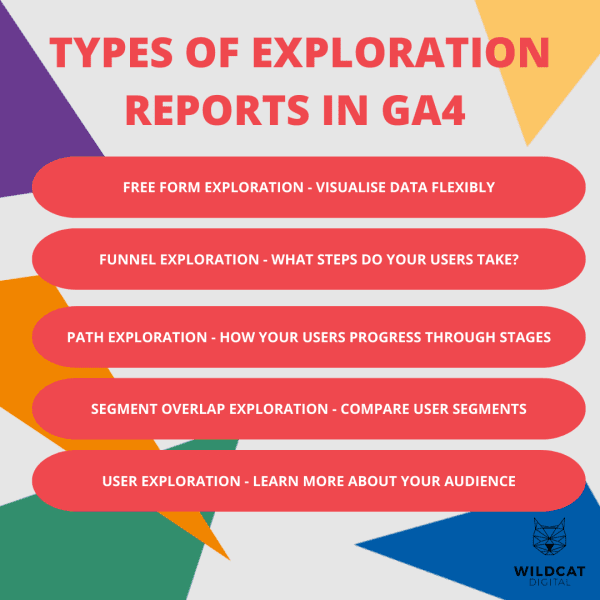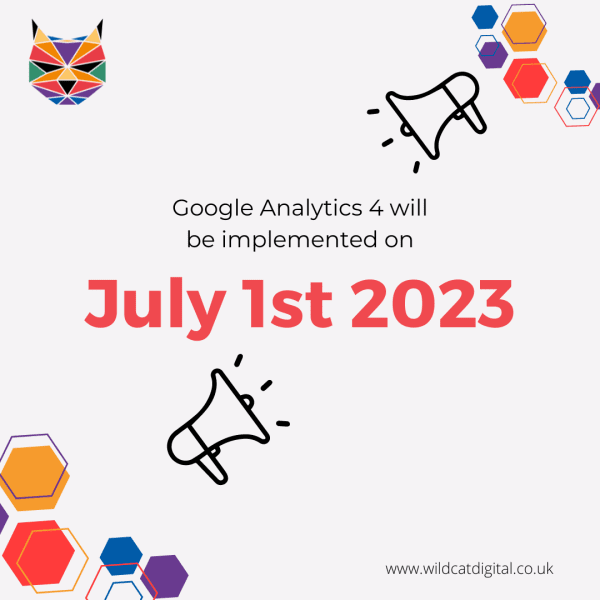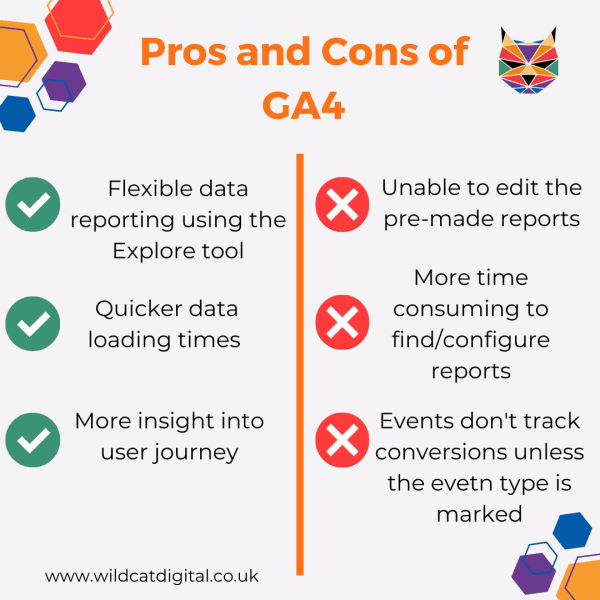Nobody enjoys change. So, when the news was announced in October 2020 that Google Analytics was switching from Universal Analytics to GA4 in July 2023, it’s no surprise that there was an absence of enthusiasm from Analytics users around the world. Now, we don’t want to get into the SEO politics of this just yet, but it is important that you know what to do with this news on your website.
So, why should you implement GA4 before July 2023? You should switch to GA4 now, rather than in July 2023 to avoid losing your data. Switching to GA4 now means that you have time to build up historic data to compare against moving forwards. Other reasons include GA4 recording more accurate data, and the ability to see web and app data in one place.
Google wished to provide people with more in-depth information not only about how people arrived at a website, but also how people use and engage with it. This is a focus on user journey, where you can discover new, exciting reports about how users are exploring your website. And, for the first time, you can now explore both website and app data together to learn more about your audience. Sounds useful, right? This is just one of many new advantages that GA4 provides.
One of the main reasons why you need to make the switch to GA4 before July 2023 is because you can’t explore historic data. In other words, the sooner you implement the new generation of Google Analytics, the more of your data you will save and collect to explore. GA4 stores data from the date that you switch, not from the beginning of your UA data collection.
But, there are more reasons why you should make the switch sooner rather than later…
The most important reason why you should switch to GA4 before July 2023 is because it’s the future of Google Analytics. This new generation offers a wide range of new features and data to explore and play with to learn more about your website, app and audience. From storing user interactions, such as scrolling, which buttons your users are pressing or which links they’re clicking on, to creating your own unique data sets, GA4 will provide you with new tools and data to play with to learn more about your user journey. Ultimately, this will allow you to take more effective action on your data insights, and enhance your overall marketing strategy.
If this hasn’t convinced you, how does exploring your data with deduplicated users sound? An advantage of GA4 is how it removes all duplicate data, meaning that it tracks a single user journey regardless of what device or platform they’re using, such as web or app. From this, you’ll receive more precise data in all of your reports.
If you’ve used Google Analytics before, then you’ll be familiar with ‘Session’ based reporting. In GA4, this feature will be replaced with ‘Events’ based data. While this appears different and somewhat daunting, it simply means that all distinct user interaction will now be measured. This includes clicks, page scrolls or completing a transaction, which altogether will provide you with a clearer picture of how users interact with your website or app.
In Universal Analytics, only one identity space at a time was tracked, such as device. In GA4, multiple identity spaces are measured, providing you with concise cross-device and cross-platform reports to explore. This will provide you with stronger insights on the relationship between your website and/or app, and your users.
You can bring these reports together utilising GA4’s new ‘Explore’ feature. Here, you’ll be able to configure your own reports with the data that you want to examine. There are 6 new and unique Explore reports that you can configure, including Funnel Exploration for a step-by-step breakdown of your user journey, User Exploration to take a deeper dive into demographics or Free Form Exploration where you can create your own distinctive report to track the data you need. From this, you can better understand your data reports and easily acquire the insights you need.

Not only this, but a nice new added feature of GA4 is how you can easily search for the data you need using the search bar. Whether you’re lost or just looking for a quick answer to your query, the improved Properties tool allows you to answer questions like ‘How many app conversions occurred on my app last week?’ or ‘How many new users did I have last quarter?’. Perfect to use to find exactly what you need with minimal effort.

The short answer is yes…but let’s take a look at why and when.
Google will turn off Universal Analytics by July 2023. This means that GA4 will be taking over your analytics in the near future. To ease into GA4, why don’t you play around with these new features using Google’s Demo Website data? Here, you’ll be able to explore all the new features that GA4 has to offer without losing the comfort of Universal until you feel ready.
Alongside tracking moving from ‘Sessions’ to ‘Events’, what else is new? If you’ve explored GA4 before, the short answer might feel as though everything has changed.
Here’s a quick run through of everything that’s new to GA4:
The first thing you may notice is the new toolbar used to navigate GA4. The premade Google reports can be found under the ‘Reports’ tab. These will consist of your go-to generic data that tells you anything about Acquisition, Engagement, Monetization, Retention, Demographics and User Tech. It’s important to note that these reports can not be edited, they can only be filtered. It is for this reason that you’ll need the ‘Explore’ tab, which creates those custom reports that have been previously mentioned.
The ‘Advertising’ tab will provide you with a glance of your conversion performance along with other valuable information, such as the role of searches or ads. In the ‘Configuration’ tab, you’ll be able to edit and amend your tracked events to manage your data.
UA provided us with a variety of useful metrics such as bounce rates or page views. Under the new GA4, these much-loved insights have now been converted. From now on, under the new ‘Event’ based measuring, you’ll be provided with information such as ‘Engaged Sessions’, ‘Engaged Users’ and ‘Engagement Time’.
The Exploration tool is a new means to dig deeper into your data. Its power can’t be understated. These reports go beyond anything we’ve ever seen before on Google Analytics, and will provide valuable new insights to structure your marketing campaigns.

The honest answer is yes. The major changes associated with GA4 have helped Google to catch-up with the current market on website tracking. One thing you’ll start asking yourself once you become accustomed to GA4 is how you ever lived without these new reports. Despite some getting used to, Google will continue to be the most useful and respected free analytical platform used to track our data.
Luckily, setting up GA4 is nice and easy.
Simply log into your GA account, and click on the ‘Admin’ icon on the left navigation tool. Confirm your account and property, and then click on GA4 Setup Assistant. Finish by clicking on the big blue button that says ‘Get Started’, and then you’re done.
Are you interested in learning more about how to boost traffic and user engagement for your business? Our team is here to help. Simply get in touch with us to receive a free consultation detailing more about how we can help you with SEO, PPC, Paid Social, and Websites.

Founder
Our founder, Will Hitchmough, worked at a number of high profile Sheffield Digital Agencies before founding Wildcat Digital in 2018. He brings an extensive knowledge of all things related to SEO, PPC and Paid Social, as well as an expert knowledge of digital strategy.
Digital Marketing can be a minefield for many businesses, with many agencies ready to take your money without knowing how to deliver results. I founded Wildcat Digital to deliver digital success to businesses with smaller budgets in a transparent way.

Content Strategist Team Lead
With a degree in Marketing and a background in more traditional, offline marketing, Chloe joined Wildcat in 2021 after deciding to move into the digital marketing industry. She joined us as a Content Specialist and quickly moved up the ranks, becoming a Content Strategist and later an SEO Team Leader.
Outside of work, Chloe is an avid creative. If she’s not knitting, you’ll likely find her behind a sewing machine or in the kitchen trying (and often failing!) to make sourdough.

SEO Account Director
Paul has a strong background in SEO, having previously founded and ran a successful eCommerce business, as well as running a personal blog that achieves an average of 17K users per month. Paul’s knowledge of SEO is extensive, with a strong emphasis on client handling and technical SEO.
Outside of work, Paul enjoys spending time with his family and staying active with weight lifting and combat sports.

Head of Operations
Nadea joined Wildcat in 2021 and has since overhauled the way we work. She has a background in various administrative, operations and HR roles, which gave her the experience and skills needed to lead and organise a growing business.
Outside of work, Nadea loves anything that keeps her active, but she especially enjoys hiking, camping and mountain biking.

SEO Account Manager
With a background in sales, Molly is a natural Account Manager, brilliantly handling any issues that come her way. Having joined us as a Digital Marketing Executive, and working part-time through her final year of University, Molly is a shining example of how hard work pays off. She is now an SEO Account Manager with a particular interest in Content and Client Management.
In her spare time, Molly loves to get out in nature, hiking and exploring the Peak District. She also loves cooking and likes to unwind with a bit of yoga.

Senior PPC Account Manager
Libby joined Wildcat in 2021 as our first PPC hire. With a degree in Digital Media Production, a Master’s in Digital Media Management and previous experience in Social Media Management, Libby hit the ground running and has since climbed the ranks to Senior PPC Account Manager and has a particular interest in the eCommerce sector.
Outside of work, Libby likes gaming, and cooking and likes to keep active by lifting weights.

SEO Team Leader
Jasmine joined Wildcat in 2022 with a strong background in SEO and Account Management. At the time, she was finishing up a Level 4 Apprenticeship in Digital Marketing from the Chartered Institute of Marketing, and has since worked her way up to SEO Team Leader. Jasmine excels at content writing and promotion, and particularly enjoys finding creative ways to join the dots on multi-channel campaigns.
In her spare time, Jasmine volunteers at a charity, helping combat loneliness & social isolation experienced by older neighbours. Outside of Wildcat, she owns a catering company, Savery Grazing, creating delicious grazing tables & platters for a range of events. She also loves skiing and exploring the Peak District.

Senior PPC Executive
Prior to joining Wildcat, Braden founded and ran his own Social Media Management agency where he gained valuable skills in growing brands’ online presence, which has since proven invaluable in his role at Wildcat.
Outside of work, Braden is a big football fan, regularly travelling to Pride Park to support Derby County. He also enjoys watching and playing snooker, hiking in the Peak District, and attending air and car shows.

Senior SEO Executive
After spending ten years managing businesses, restaurants, cafes and event spaces across Sheffield, Jon decided to change careers and joined Wildcat as an SEO Executive in 2022. He especially enjoys the client management side of the job, helping them to understand digital marketing and ways in which they can build their business’s presence online.
Outside of work, Jon likes to keep fit with running, badminton and football, and also loves music.

SEO Executive
Rachel joined us as a graduate, having recently graduated from Sheffield University with a degree in English Literature. Since joining, Rachel has proven herself to be a Content Queen, and particularly enjoys getting stuck into projects that allow her to explore her creative side.
Outside of work, Rachel enjoys a wide range of hobbies, including rugby, singing, reading, and spending time with her family and three labradors.

PPC Team Leader
Carl joined Wildcat in 2023 with a wealth of experience in PPC. He has experience working with a wide range of clients, industries and budgets, from small local businesses all the way to international e-commerce businesses. Carl has a particular interest in strategic planning and forecasting. He is passionate about data analysis and creating sustainable long-term cross-channel strategies.
In his spare time, Carl enjoys keeping fit by lifting weights, bouldering and running. He’s also a keen musician, having played the double bass and bass guitar for 20 years.

Team Lead & Technical SEO Account Manager
With a degree in Computer Science and SEO experience dating back to 2017, Dariusz has a wide range of SEO skills and knowledge. His specialist knowledge of Technical SEO has firmly landed him the title of Wildcat’s Technical Wizard, and he has recently taken on the responsibility of Team Leader for the Panthers Team.
In his spare time, Dariusz loves hiking, experimenting and trying new coffees and loves learning new things. He is currently learning more about CRO and AI and how this could benefit our clients.

SEO Account Manager
With a degree in Film and TV production, and a varied career history, Jamie made the move to marketing with a Masters degree in Digital Media Management. He has since worked in SEO at Agencies across Sheffield, before joining Wildcat and working his way up to SEO Account Manager. Jamie has a particular interest in backlinks and Digital PR and has recently gained a client a valuable backlink from Forbes!
In his spare time, Jamie is an avid foodie and loves trying new restaurants and cuisines. He also loves to travel and spent a year travelling to Australia after university.

SEO Executive
Andy joined Wildcat in 2023 after starting his digital marketing career in-house for a local Sheffield company. Since joining, he has developed a strong interest in Technical SEO and has strong skills in Account Management.
Outside of work, Andy loves music and plays in a couple of bands. He also enjoys rock climbing, cycling, photography and good food.

Client Success Coordinator
Siena joined us in 2023 with a background in sales and digital marketing. She leads on client relationships across the company, ensuring that our customers are happy throughout their journey with us, from their initial consultation through to onboarding and beyond.
Outside of work, Siena enjoys travelling and getting stuck into the local culture. She likes to make the most of her experiences and particularly enjoys watching sunrises and sunsets from beautiful locations around the world.

Senior SEO Executive
Thea has a wealth of experience in SEO, having previously worked for other Digital Marketing Agencies in Sheffield. She has a particular interest and skills in Technical SEO, but is more than willing to get stuck in and give anything a go.
Outside of work, Thea spends most of her time with her children, but also loves reading, photography and gardening.

PPC Executive
Before joining Wildcat, Tom worked across different industries, building skills in sales and customer service. He later developed a passion for digital marketing whilst working on personal marketing projects and freelance ventures, and gained numerous certifications in PPC and Social Media.
Outside of work, Tom enjoys staying active by going to the gym and hiking. He also loves travelling and motorbiking.

Head of Growth
Rich joined us in May 2024 to head up our growth team. With years of experience helping other agencies to grow, Rich joins us at an exciting time as Wildcat is working on a five-year plan to become one of the biggest agencies in the UK.
Outside of work, Rich is a father to three children, which keeps him very busy! He’s also recently started running again to keep fit and loves a bit of DIY.

July 23, 2024
Search intent (also known as user intent) is the goal of the user when they search a query on Google.…

July 22, 2024
Redirects in general can be a confusing topic, knowing when to use one and why is key. There are a…

July 12, 2024
Welcome to our July Marketing Roundup! As we reach the height of summer, the marketing world is heating up with…